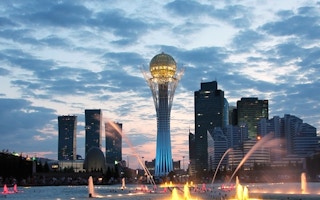Kazakhstan has set itself a tough goal: it aspires to become one of the top 30 competitive developed countries in the world by 2050 while gradually ‘greening’ key economic sectors.
For an oil-producing country which has been in transition since the 1990s, Kazakhstan’s ambitions present many opportunities. But moving away from a ‘brown’ economy to a green one also poses challenges.
In a new report published today, IIED assesses the situation in Kazakhstan and recommends ten ways the country can smooth the challenging transition to an economy that is not only green but also inclusive.
“
The country aims to diversify the economy with alternative, cleaner sources of energy and will reform its agricultural and industrial sectors to spur scientific innovation and the use of advanced technologies
From the top down
Kazakhstan’s Green Economy Concept policy, which it adopted in May 2013, emerged in response to the Rio+20 ‘Earth Summit’ the year before. President Nazarbayev has since reaffirmed his government’s commitment to mainstreaming the green economy agenda into national development, in a speech in January 2014.
The country aims to diversify the economy with alternative, cleaner sources of energy and will reform its agricultural and industrial sectors to spur scientific innovation and the use of advanced technologies.
Such strong government endorsement should stimulate economic drivers of green development. Of course, ‘greening’ the economy of an oil-producing resource-based country requires sustained political commitment, significant long-term investments and a range of other enabling conditions.
Our report is an effort to ask difficult questions and start discussing potential pathways and available options. It draws on earlier work in IIED’s Caspian Energy Initiative as well as a green economy ‘dialogue’ that IIED and the Kazakhstan Ministry of Environment organised in 2011.
Our recommendations
- Focus the green economy policy concept on specific sectors such as renewable energy, energy efficiency, water governance or waste management
- Assess the viability of the proposed investment mechanisms and ensure a wide variety of economic actors, not just the largest technology and infrastructure players, can access them
- Establish coherent measures to mainstream the green economy — such as a multi-stakeholder green economy forum, screening of public expenditure, green accounting
- Set up an inter-agency green economy coordinating body with a regulatory mandate, for example, a State Commission or a Council under the President (the Sustainable Development Council offers lessons)
- Increase Kazakh institutional capacities and governance, to improve accountability and enable effective public oversight of the green economy programme
- Carry out fiscal reform to shift incentives from ‘brown’ to green economic activities, and towards inclusive approaches
- Review subsidies and other incentives, notably in the oil and gas, mining and agricultural sectors. Subsidies should address the social as well as the environmental impacts
- Ensure public finance accountability and oversight over new environmental programmes, for example by integrating Extractive Industries Transparency Initiative approaches into a wider range of economic activities
- Adopt a step-by-step approach in order to create dialogue and engagement with Kazakh industries and businesses — and a strong business case for the green economy concept.
- Develop a strong communication strategy to support policy breakthroughs in the short-to-mid-term, in order to promote investment in renewable energy, energy efficiency, water and waste management technologies.
Opportunities to learn and show progress
In the coming years Kazakhstan’s progress towards a green economy will be on display in the following forums:
- The Green Economy Coalition is the world’s largest multi-stakeholder network working on green economy, committed to accelerating the transition to a green and fair economy
- The Partnership for Action on Green Economy (PAGE) will support 30 countries over the next seven years to build national green economy strategies that will generate new jobs and skills, promote clean technologies, and reduce environmental risks and poverty. Progress around countries’ green economy transitions, including Kazakhstan’s, will be discussed at an upcoming first global PAGE conference in the United Arab Emirates in March 2014
- In 2017, Kazakhstan’s new capital city Astana will host the international trade fair, EXPO. It has chosen the theme Future Energy, which aims to “promote and discover sustainable, energy solutions”.
The target date of 2050 is just over 35 years away. The next few years will be crucial for laying the groundwork if Kazakhstan is to make a meaningful transition to a green inclusive economy by then.
Domestic support is essential, while international engagement can help to ensure that the process is more inclusive and brings benefits across Kazakhstan’s population. New international financial and institutional instruments are also needed to support Kazakhstan’s national endeavours to embrace a greener future.
Download the report: Assessing Kazakhstan’s policy and institutional framework for a green economy
Saule Ospanova is an independent researcher working on sustainability and accountability initiatives in the extractive sector, as well as development of energy, water and climate change policies. (ospanovs@hotmail.com) This post originally appeared here.










